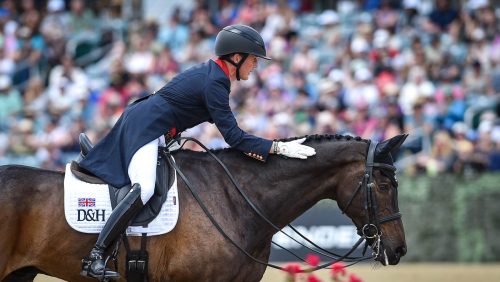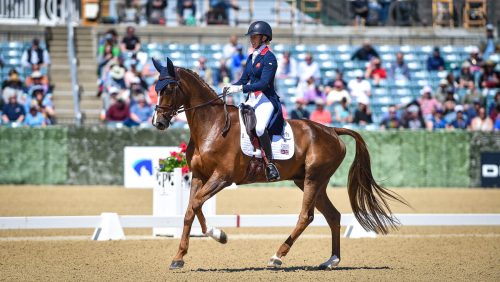As he sat in the dirt after a young horse tossed him off while schooling in March of 2018 staring at an exposed portion of white bone, veterinarian Kevin Keane, DVM, knew he was in a bad situation.
“I was doing very elementary exercises, and basically he let out a little bit of a buck, and I more or less stepped off of him, but when I did, my leg was at an angle,” said Keane. “This is apparently a common injury in people who are stepping off a ladder. It was really an innocent maneuver on the horse’s part.
“What happened was, both my tibia and fibula splintered, and they came out the bottom of my leg,” he continued. “I was in an outdoor arena, where it had rained the day before, and so there was a significant amount of water and dirt around, presumably some horse manure also. I had what they call an open fracture, where the bones are projected out of the leg. The negative aspect of being a vet is the minute I saw my tibia sticking out I thought, ‘Well, this is real, real bad.’ ”
Keane, 65, runs a practice specializing in equine sports medicine in Chester County, Pennsylvania, where his clients include eventers, steeplechasers, jumpers and dressage horses. Orthopedics and lameness are a central part of his work.
So he understood exactly how dangerous open fractures can be because of their high risk for infection when they happen around water. Or dirt. Or horse manure. The tibia, particularly the lower part of the bone, is notorious for poor healing in humans because of its decreased blood supply. Keane’s fracture was just above his ankle, and his ankle joint was also exposed.
Keane directed those at the farm to call for an ambulance and get him to a trauma center. He picked up a call from coach, veterinary client and close friend Phillip Dutton, who’d heard about the young horse that had been found without a rider.
“This isn’t the worst thing,” he told Dutton. “I’m looking at my tibia, but I didn’t hit my head.”
At the hospital, surgeons flushed out the fractures and put Keane in traction, but his leg was too swollen for surgery at first. Ten days later, he learned surgery would be complicated, so he flew from Aiken, South Carolina, where the accident happened, to Thomas Jefferson University Hospital in Philadelphia, where top trauma surgeon Dr. James Krieg performed the operation.
ADVERTISEMENT
Months later the pain persisted.
“I wasn’t doing particularly well for about four months,” Keane said. “I didn’t look well. [Krieg] kept saying, ‘Something isn’t right.’ Of course, I couldn’t walk. I was actually unable to walk normally for almost a year.”
Keane’s vitals were checked daily to detect any possible infection, and they remained normal, so he returned to work, observing his cases while perched on a stool or hobbling around on crutches. Then, a few months after the operation, his leg adopted a slight curvature that no one could explain. Krieg suggested another surgery, and this time, he took tissue biopsies of the area around Keane’s tibia.
“He came in a little bit like this Dr. House that we have on television and pronounces a brilliant diagnosis. He announced the name of the bacteria, which is an enterococcus,” recalled Keane. “Enterococcus actually grows in horse manure. Basically, they realized my leg had been infected for four months, but my body never registered any sign of infection with fever or bloodwork. If he hadn’t done that biopsy they never would have known. He said, ‘Now you realize most people that have what you have would’ve gone to the ER in the middle of the night for intractable pain.’
“I had been in quite a lot of pain from the bone being infected, but I thought it was because of the fracture and was more or less what I had to endure healing up,” Keane continued.
Now that they’d identified the problem, they could treat it with a strong combination of antibiotics. But if the drugs failed, Krieg told Keane they’d likely have to amputate. For months Keane gave himself intravenous antibiotics every day at the same time.
The treatment was a success, and Keane believes his attitude was as important an aspect of his recovery as any other. Krieg agreed.
“He told me that as doctors, we pretty much put the pieces back in order, but it really is up to the patients and their mental attitude and their tendency to keep trying to get over the injury,” said Keane. “That’s pretty much what I did.”
ADVERTISEMENT

Kevin Keane competed at the Rolex Kentucky CCI5*-L in 2014 with Fernhill Flutter. Chronicle Archives Photo
It was nearly a year before Keane got back in the saddle. The many hours spent on crutches had left him with a loss of sensation in both feet, and Keane worked up gradually from short jogs to longer flatwork to crossrails. Eager to return to competition, he asked Dutton if he could enter a horse trial and just take the cross-country slow. Dutton cautioned him that jumping was going to be harder than he thought.
Naturally, Dutton was right. For several months, Keane had to look down at his feet before a jump to verify the position of the stirrup because he couldn’t feel it.
“I wanted it so badly that I basically did not have any fear,” Keane said. “What I would do is I’d be cautious riding a horse by myself. When I rode I’d make sure 1) I had a cell phone on me and 2) that there was someone in proximity to me so that if I happened to fall off due to weakness in my legs I’d have a chance of getting some help.”
Keane, who competed at the Rolex Kentucky CCI5*-L in 2014 with Fernhill Flutter, started competing again in January 2019, when he finished fifth at novice with HH Ontario, a now 8-year-old Irish Sport Horse.
Now, Keane is back to his usual schedule—which is a busy one. In addition to his veterinary practice, he competes Sportsfield Candy, his 13-year-old Irish Sport Horse whom he’s campaigned at advanced, and HH Ontario, who’s been cleaning up at preliminary, winning at Sporting Days (South Carolina) and the Horse Park of New Jersey Horse Trials this year. Keane sneaks rides in between cases and said that if he’s awake, he’s working or he’s riding. There isn’t room for much else.

After nearly a year out of the saddle following an open fracture that almost resulted in the amputation of his leg, Kevin Keane returned to competing at the upper levels of eventing. Lindsay Berreth Photo
He hopes to continue riding at the advanced level as long as he physically can and wants to do a long-format four-star later this fall if the pandemic allows. Keane has also enjoyed the process of training Ontario and looks forward to bringing more young prospects through the ranks. As he approaches his 66th birthday, Keane’s vision of an eventual retirement from eventing is far off and probably involves show jumping.
“I have no plans of slowing down whatsoever,” he said.
Do you know a horse or rider who returned to the competition ring after what should have been a life-threatening or career-ending injury or illness? Email Kimberly at kloushin@coth.com with their story.















